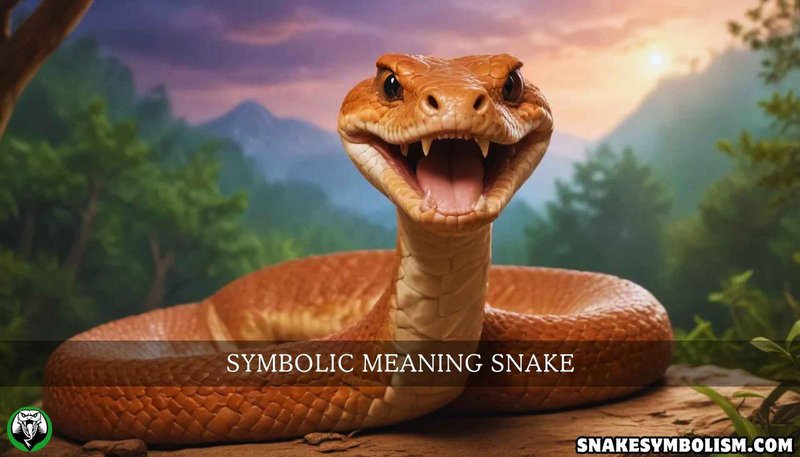
Let’s dive into what makes the snake so central in culture and symbolism. Think of it like unwrapping a present—you never know what you’ll find inside. Whether you’re gazing at ancient art or reading mystical stories, understanding the importance of the snake can give us insight into human history and our shared experiences. So grab a cup of coffee and let’s explore this fascinating topic together.
Snakes in Ancient Mythologies
Many ancient cultures featured snakes prominently in their myths and legends. For instance, in Greek mythology, the snake is often associated with Asclepius, the god of medicine. His rod, entwined with a snake, is a symbol of healing that we still see in medical icons today. This intertwining of the snake with health reflects how these creatures can convey dual meanings—life-giving and dangerous at the same time.
In Hindu culture, the serpent known as Naga represents fertility, water, and the cycle of life. Nagas are often depicted as protectors of springs and rivers, showcasing the snake’s role in nurturing life. With their ability to navigate both land and water, snakes embody a bridge between the physical and spiritual worlds, further enhancing their symbolic importance.
These examples reveal that throughout history, snakes have often been seen as messengers or guardians, reflecting the complexities of human experiences. They embody our fears, aspirations, and the mysteries of existence, making them a powerful symbol across different cultures.
The Serpent as a Symbol of Transformation
You might be wondering why transformation is such a big deal when it comes to snakes. Well, snakes are unique because they literally shed their skin to grow. This act of shedding can be seen as a metaphor for personal change. It’s no wonder that many cultures view the snake as a symbol of renewal and transformation.
In the story of the biblical serpent in the Garden of Eden, the snake represents temptation and knowledge. Eating the forbidden fruit leads to profound change for Adam and Eve—it’s as if they shed their innocence. Similarly, in alchemical traditions, the snake often guides the transformation from base materials to something more refined. It’s a reminder that transformation can be uncomfortable, but it can also lead to profound growth.
This idea of transformation weaves through various narratives, showing that while change can be daunting, it’s also a necessary part of life. Snakes remind us that sometimes, we need to shed old ways to embrace new beginnings.
Snakes in Spiritual Practices
Many spiritual practices incorporate snakes into their symbolism, often as guides in meditative journeys. For example, in Buddhism, the Naga is revered as a protector of the Dharma, embodying wisdom and spiritual teachings. They symbolize the potential for enlightenment and the vital connection between humanity and the natural world.
In some African traditions, snakes are seen as powerful ancestral spirits that can provide guidance. The Yoruba people, for instance, regard the Olokun, a water deity represented by a serpent, as a source of wisdom and abundance. Practitioners might call upon these spirits for protection and insight during rituals.
These examples highlight how snakes serve as channels for spiritual wisdom. Whether they’re representing the cycle of life or facilitating enlightenment, they invite us to explore deeper truths about ourselves and the universe.
Cultural Interpretations of Snakes
Cultural interpretations of snakes can vary vastly, reflecting the values, fears, and beliefs of a society. In Western cultures, snakes often carry a negative connotation. You might see them portrayed as treacherous or deceitful, like in the classic tale of Medusa, where her snake hair symbolizes danger and fear.
On the flip side, many Indigenous cultures view snakes more positively. For instance, in some Native American traditions, snakes symbolize healing and transformation. They’re seen as allies in medicine, sometimes used in rituals to connect with the spirit world and promote physical well-being.
This dichotomy shows how context shapes the perception of snakes. What one culture might see as a threat, another might embrace as a source of wisdom. This variation reminds us that understanding cultural differences can lead to richer insights into our shared human experience.
Snakes in Art and Literature
Snakes have inspired countless artists and writers throughout history, showing up in paintings, sculptures, and stories. In the famous painting “The Fall of Man” by Albrecht Dürer, the snake plays a pivotal role in the biblical narrative. Here, it symbolizes temptation and the consequences of human choice, reflecting deep psychological themes.
In literature, snakes often embody duality. For example, in the work of Herman Melville, the snake can represent both life’s beauty and its danger. This often mirrors our own struggles with temptation and morality. Through these representations, snakes challenge us to confront our fears and desires, making them compelling symbols in storytelling.
Art and literature have a unique way of capturing the essence of snakes, demonstrating their complex role in society. They compel us to reflect on our beliefs and the transformative power of both fear and rebirth.
Modern Interpretations and Symbolism
In today’s world, snakes still hold significant symbolism, particularly in discussions around personal growth and resilience. You might encounter sayings such as “like a snake shedding its skin” to describe someone going through a tough time but emerging stronger. This modern interpretation continues the age-old tradition of snakes being symbols of change and renewal.
Social media has also contributed to the evolving narrative of snakes. Memes and graphics often play with snake imagery, portraying them as misunderstood creatures or symbols of empowerment. This shift allows for a more nuanced understanding of snakes as beings that evoke both fear and admiration.
By examining modern interpretations, we can see how culture evolves while still holding onto the core meanings that snakes have represented throughout history. They remind us that life is about embracing change, whether we perceive it as positive or negative.
The Snake’s Role in Conservation and Nature
Lastly, snakes play a crucial role in our ecosystems, and their importance in culture extends to conversations about conservation. As predators, they help control populations of pests and rodents, ensuring a balanced environment. This ecological role highlights their significance beyond just symbolism—snakes contribute to the health of our planet.
Unfortunately, many snake species face threats from habitat loss and climate change. As we navigate these issues, understanding the symbolic importance of snakes can inspire people to protect them. After all, appreciating these creatures goes hand in hand with caring for the ecosystems they inhabit.
Conservation efforts can also draw on cultural symbolism. Programs that celebrate the role of snakes in various traditions can foster a deeper appreciation for these reptiles, encouraging communities to advocate for their protection.
In conclusion, the snake is far more than a simple creature slithering through grass. Across cultures, it symbolizes transformation, wisdom, and the complex nature of existence. Whether through art, mythology, or conservation efforts, snakes invite us to reflect on our journey through life, reminding us of the beauty in change and the importance of embracing both our fears and our potential for growth.

